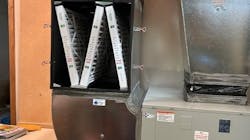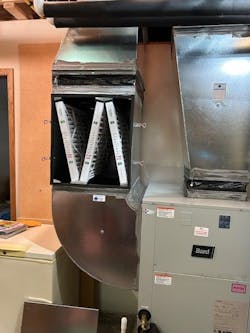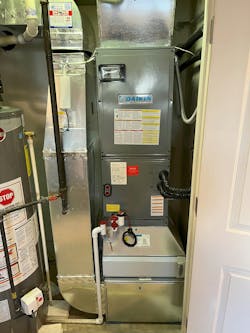With the start of the new year, most of us have grand ideas about how we will make positive changes in our companies and personal lives. A common phrase for this phenomenon is “turning over a new leaf.” While most New Year’s resolutions lose their steam before the end of January, it is more likely that a new habit will stick around if it immediately impacts our pocketbooks.
In this article, I review my top three items for owners and managers to implement in residential HVAC that will take a company’s installations to the next level.
If you can navigate the obstacles of lasting change, I promise you will have fewer warranty calls, and more of your installations will perform as designed. For years, I thought a quality installation meant straight pipes and clean metal work, but when I paid more attention to system design, I started installing true high-performing HVAC systems.
Perform On-Site 10 Minute Load Calculations
For years, I heard sales gurus preach the importance of showing value to potential customers. Unfortunately, showing value means different things to different people. I wrote an article for HVAC School called Is Value Perceived. The article describes the difference between perceived and delivered value, describing the facade companies portray to customers.
I would rather provide a quality service for a customer and deliver a system that operates as designed rather than lining the mechanical closet walls with bubble wrap insulation and LED lights like you see some of the HVAC social media influencers doing while claiming “they do things differently.”
Equipment sizing is one of the most significant issues in the Chicagoland area. Today, the industry’s standard practice is to replace a system with like-sized equipment or even increase equipment capacity to help heat or cool uncomfortable rooms in the house. The problem with this mindset is that you assume the guy who designed the previous system knew what he was doing.
When you start performing load calculations on every job, you will find that most HVAC equipment is oversized - some grossly oversized. Once you understand most equipment failures are due to a lack of airflow and commissioning, things will fall into place for your company. Smaller equipment has lower airflow requirements.
So, by reducing the airflow requirement, you instantly reduce the total external static pressure because less air moves through the existing ducts. Reduced static pressure means fewer blower motor, compressor, and heat exchanger failures.
The slower air moves through a filter, the more efficient the filtering media is. Increasing its surface area is the only way to reduce air velocity through a filter. Increasing filter size allows for even filter loading and longer filter life.
Conduit Tech and Amply Energy use the Lidar technology in an Apple iPad Pro to create a 3D model of a home. The apps allow you to quickly scan all the home's surface areas and use the data to calculate the structure's heat loss and gain.
Most customers will immediately see the value in your service because you aren’t making your sizing recommendations based on the existing equipment’s data tag. Instead, you’re using technology and math to guide your recommendations.
Test Your Sales Skills (With Data)
You may rely on a “selling tech” or send out a professional salesperson when selling new systems. Both methods have pros and cons, and I am not sure one is necessarily better than the other. The following process is a bit tougher to normalize if you employ salespeople in your company. I have seen it done and personally helped work through the details, so I know it is possible.
First, start pressure profiling your customer’s existing equipment and ductwork, then measure or plot the fan airflow. This needs to happen on ALL sales calls.
I know what you’re thinking: my salesperson doesn’t own a drill, nor would I trust him to use one. Installing a test port isn’t rocket science. Give your salespeople some credit. With some guidance and an inexpensive 12-volt drill, they can take the measurements to analyze your customer’s current duct system.
By the way, I am not suggesting that salespeople must be capable of analyzing the data they collect. A handoff might need to occur within your company to someone capable of diagnosing any current or future airflow issues.
The goal is to determine where there are problems in the duct system that will hurt equipment performance. Identifying issues upfront allows you to make recommendations to customers before installing any new equipment. You will prevent problems upfront by presenting options to ensure their equipment performs as intended.
Next, compare the pressure measurements to static pressure budgets. Don’t forget that if the fan airflow is low, any pressure measurement will get worse if you increase the fan airflow. This often happens with new installations, especially when replacing a furnace or air handler that had a permanent split capacitor (PSC) blower with a variable speed or constant torque motor.
When you notice a red flag, plan for future duct pressures by recommending Air Upgrades™. I wrote another HVAC School article called “Replacing Residential HVAC Equipment with Predictable Results.” In this article, I discuss how to use Fan Law 2 when planning for a system replacement.
Include Enhanced Filtration
Most companies are conditioned to look at upgraded filtration as an option. When you consider Total External Static Pressure (TESP) and filter pressure drops, you realize that a good media filter with more surface area is a necessity, not an option.
Proper filtration should either be sized by air velocity or pressure drop in a retrofit situation. Filters are one of the biggest choke points directly impacting TESP and fan airflow. By reducing the choke point, you also reduce TESP.
I see HVAC companies installing small media filter sizes like 16”x20” x 4” or 16”x25”x4”. If you have the room to install a larger media filter like a 20”x25”x4”, a 25”x25”x4” or even a 31”x28”x4”, never use the smaller filter, even for smaller equipment.
My philosophy for filter sizing is, “go big or go home!” This is the easiest way to reduce static pressure. I have installed 25”x25”x4” filters on 40,000 BTU furnaces and 1.5-ton condensers.
Remember, the slower air moves through a filter, the more efficient the filtering media is. Increasing its surface area is the only way to reduce air velocity through a filter. Increasing filter size allows for even filter loading and longer filter life.
Another benefit of low velocity is reduced filter bypass. Have you ever noticed an evaporator coil plugged up with a media filter installed? Duct leakage and filter bypass are the main reasons an evaporator gets plugged.
Slow down the air, and you catch more airborne particulates, reduce TESP, and increase fan airflow.
When the ball drops at midnight, consider taking your installations to the next level by implementing proper equipment sizing, pressure profiling on sales calls, and including upgraded filtration with your installations. With a little work and persistence, 2025 could be the beginning of your path to performance.
Adam Mufich serves the HVAC industry as a content developer and instructor for National Comfort Institute, Inc. (NCI). NCI specializes in training that focuses on improving, measuring, and verifying HVAC and Building Performance.
If you’re an HVAC contractor or technician interested in learning more about airflow diagnostics, contact Adam at ncilink.com/ContactMe. NCI’s website www.nationalcomfortinstitute.com is full of free information to help you improve your professionalism and strengthen your company.
About the Author
Adam Mufich
content developer and instructor
Adam Mufich serves the HVAC industry as content developer and instructor for National Comfort Institute, Inc. (NCI). NCI specializes in training that focuses on improving, measuring, and verifying HVAC and Building Performance. Find them at www.nationalcomfortinstitute.com.


